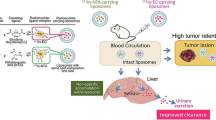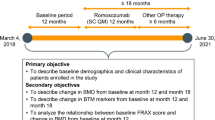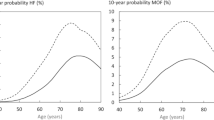Abstract
Objective
Various phosphonate ligands labeled with β−-emitting radionuclides have shown good efficacy for bone pain palliation. In this study, a new agent for bone pain palliation has been developed.
Methods
153Sm-(4-{[(bis(phosphonomethyl))carbamoyl]methyl}-7,10-bis(carboxymethyl)-1,4,7,10-tetraazacyclododec-1-yl) acetic acid (153Sm-BPAMD) complex was prepared using BPAMD ligand and 153SmCl3. The effect of various parameters on the labeling yield of 153Sm-BPAMD including ligand concentration, pH, temperature and reaction time were studied. Radiochemical purity of the radiolabeled complex was checked by instant thin layer chromatography (ITLC). Stability studies of the complex in the final preparation and in the presence of human serum were performed up to 48 h. Partition coefficient and hydroxyapatite (HA) binding of the complex were investigated and biodistribution studies (SPECT imaging and scarification) were performed after injection of the complex to Syrian mice up to 48 h post-injection. The biodistribution of the complex was compared with the biodistribution of the 153Sm cation in the same type mice.
Results
153Sm-BPAMD was prepared in high radiochemical purity >98 % and specific activity of 267 GBq/mmol at the optimal conditions. The complex demonstrated significant stability at room temperature and in human serum at least for 48 h. HA binding assay demonstrated that at the amount of more than 5 mg, approximately, all radiolabeled complex was bound to HA. At the pH 7.4, LogP o/w was −1.86 ± 0.02. Both SPECT and scarification showed major accumulation of the labeled compound in the bone tissue.
Conclusion
The results show that 153Sm-BPAMD has interesting characteristics as an agent for bone pain palliation; however, further biological studies in other mammals are still needed.





Similar content being viewed by others
References
IAEA-TECDOC-1549. Criteria for palliation of bone metastases—clinical applications. Austria, Vienna: IAEA; 2007.
Lipton A. Pathophysiology of Bone Metastases: how this knowledge may lead to therapeutic intervention. J Support Oncol. 2004;2:205–20.
Eary JF, Collins C, Stabin M, Vernon C, Petersdorf S, Baker M, et al. Samarium-153-EDTMP biodistribution and dosimetry estimation. J Nucl Med. 1993;34:1031–6.
Rajendran JG, Eary JF, Bensinger W, Durack LD, Vernon C, Fritzberg A. High-dose 166Ho-DOTMP in myeloablative treatment of multiple myeloma: pharmacokinetics, biodistribution, and absorbed dose estimation. J Nucl Med. 2002;43:1383–90.
Farhanghi M, Holmes RA, Volkert WA, Logan KW, Singh A. Samarium-153-EDTMP: pharmacokinetic, toxicity and pain response using an escalating dose schedule in treatment of metastatic bone cancer. J Nucl Med. 1992;33:1451–8.
Fellnera M, Biesalski B, Bausbacher N, Kubícek V, Hermann P, Rösch F, et al. 68Ga-BPAMD: PET-imaging of bone metastases with a generator based positron emitter. Nucl Med Biol. 2012;39:993–9.
Fellner M, Baum RP, Kubícek V, Hermann P, Lukeš I, Prasad V, et al. PET/CT imaging of osteoblastic bone metastases with 68Ga-bisphosphonates:first human study. Eur J Nucl Med Mol Imaging. 2010;37:834.
Ouadi A, Loussouarn A, Morandeau L, Remaud P, Faivre-Chauvet A, Webb J, et al. Influence of trans-l,2-diaminocyclohexane structure and mixed carboxylic/phosphonic group combinations on samarium-153 chelation capacity and stability. Eur J Med Chem. 2004;39:467–72.
Pandit-Taskar N, Batraki M, Divgi CR. Radiopharmaceutical therapy for palliation of bone pain from osseous metastases. J Nucl Med. 2004;45:1358–65.
Ferro-Flores G, Ramírez FD, Tendilla JI, Pimentel-González G, Murphy CA, Meléndez-Alafort L, et al. Preparation and pharmacokinetics of samarium(III)-153-labeled DTPA-bis-biotin. Characterization and theoretical studies of the samarium(III)-152 conjugate. Bioconjug Chem. 1999;10:726–34.
Neves M, Gano L, Pereira N, Costa MC, Costa MR, Chandia M, et al. Synthesis, characterization and bio-distribution of bisphosphonates 153Sm complexes: correlation with molecular modeling interaction studies. Nucl Med Biol. 2002;29:329–38.
Du XL, Zhang TL, Yuan L, Zhao YY, Li RC, Wang K, et al. Complexation of ytterbium to human transferrin and its uptake by K562 cells. Eur J Biochem. 2002;269:6082–90.
Bahrami-Samani A, Ghannadi-Maragheh M, Jalilian AR, Shirvani-Arani S, Meftahi M, Moradkhani S. Production, quality control and biological evaluation of 153Sm-EDTMP in wild-type rodents. Iran J Nucl Med. 2009;17:12–9.
Author information
Authors and Affiliations
Corresponding author
Ethics declarations
Conflict of interest
The authors declare that they have no conflict.
Financial support
This work was supported by Nuclear Science & Technology Research Institute (NSTRI).
Rights and permissions
About this article
Cite this article
Rabie, A., Enayati, R., Yousefnia, H. et al. Preparation, quality control and biodistribution assessment of 153Sm-BPAMD as a novel agent for bone pain palliation therapy. Ann Nucl Med 29, 870–876 (2015). https://doi.org/10.1007/s12149-015-1014-2
Received:
Accepted:
Published:
Issue Date:
DOI: https://doi.org/10.1007/s12149-015-1014-2




